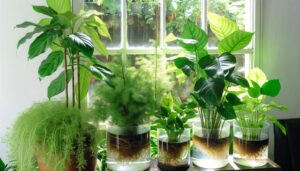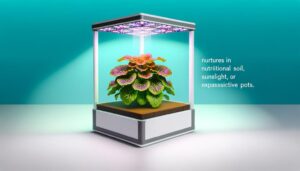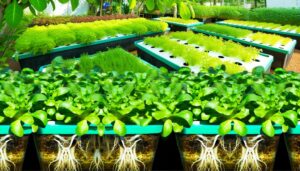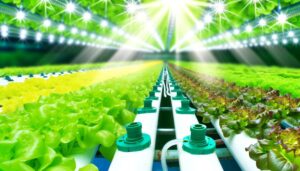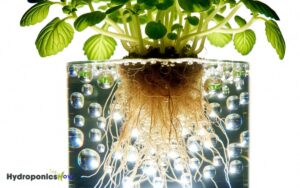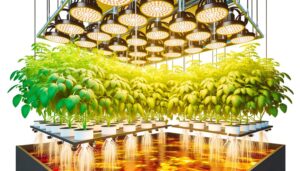How Do Hydroponic Plants Grow?
In hydroponics, plants grow by absorbing a nutrient-rich water solution directly through their roots, bypassing the need for soil.
You promote ideal growth by maintaining essential macronutrient (N, P, K) and micronutrient (Fe, Mn, Zn) levels. The pH range should be kept between 5.5 and 6.5 to maximize nutrient solubility and uptake.
Different systems, like NFT and aeroponics, regulate oxygen and nutrient delivery efficiently. Proper light management, providing both blue light for vegetative growth and red light for flowering, is vital.
Effective watering techniques and consistent environmental controls support robust plant development. For a deeper understanding, discover more factors influencing hydroponic success.
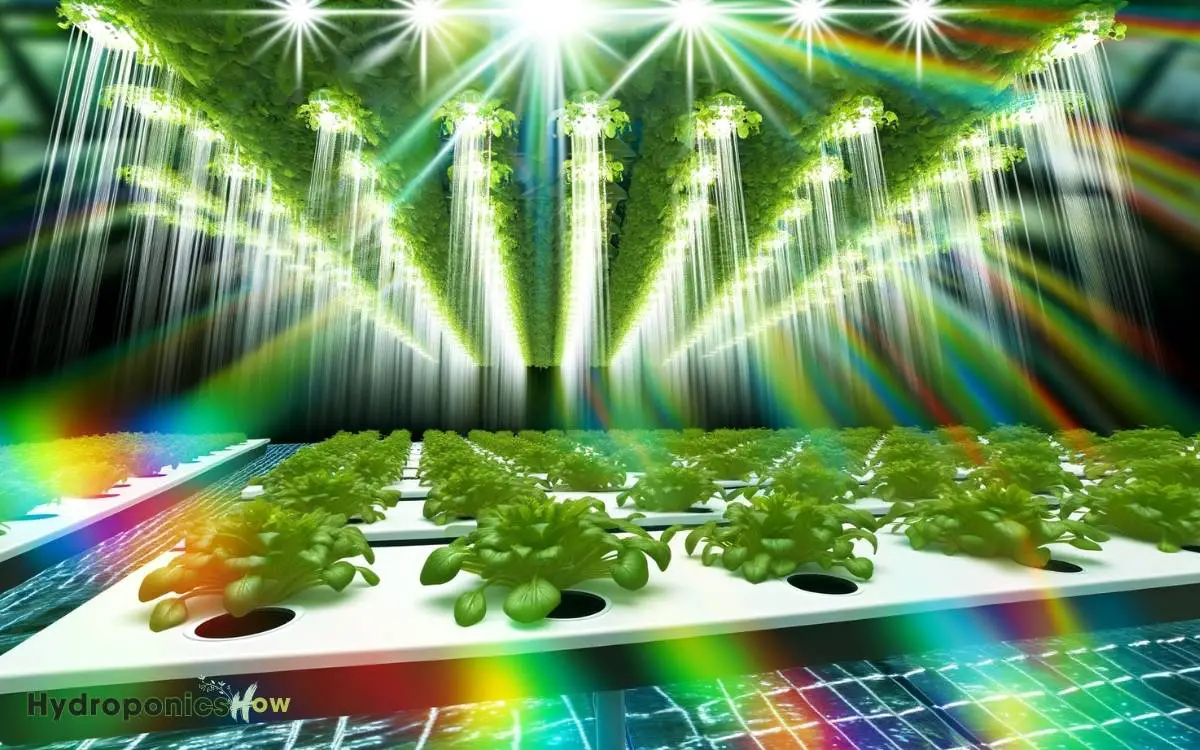
Key Takeaways
The Basics of Hydroponics
In hydroponics, plants grow without soil by absorbing nutrients directly from a water-based solution. This method maximizes resource use and enhances growth efficiency.
You’ll find that hydroponic systems leverage various structures like nutrient film technique (NFT), deep water culture (DWC), and aeroponics to deliver the nutrient solution.
These systems guarantee roots are constantly exposed to oxygen and nutrients, promoting rapid growth and higher yields.
Key components include grow lights for photosynthesis, pH meters to maintain ideal nutrient absorption, and air pumps to oxygenate the water. By controlling environmental factors, you can minimize pests and diseases, maximizing plant health and productivity.
Hydroponics represents a precise, scientific approach to cultivation, transforming traditional agricultural practices. By growing plants in nutrient-rich water instead of soil, this method allows for greater control over growing conditions, leading to higher yields and faster growth rates. Additionally, hydroponic plants and pesticides interact differently than in traditional farming, as controlled environments reduce the need for chemical treatments. As a result, hydroponics offers a more sustainable and efficient alternative to conventional agriculture.
Nutrient Solutions Explained
To optimize plant growth in hydroponics, you need to understand the precise formulation and balance of nutrient solutions, which provide essential minerals and elements directly to the plant roots.
These solutions are meticulously crafted to include macronutrients like nitrogen, phosphorus, and potassium, as well as micronutrients such as iron, manganese, and zinc.
Each element plays a critical role in various physiological processes, from photosynthesis to cellular respiration.
| Essential Nutrient | Function |
|---|---|
| Nitrogen (N) | Leaf growth and chlorophyll production |
| Phosphorus (P) | Root development and energy transfer |
| Potassium (K) | Disease resistance and water regulation |
| Iron (Fe) | Chlorophyll synthesis and enzyme function |
Understanding the exact needs of your plants and regularly adjusting your nutrient solution ensures optimal growth and health.
Importance of Ph Levels
Understanding pH levels is essential for hydroponic systems, as they directly influence nutrient solubility and plant absorption rates.
You’ll need to maintain an ideal pH range, typically between 5.5 and 6.5, to guarantee nutrient availability.
Employ precise pH monitoring techniques and corrective measures to address any imbalances that could impede plant growth.
Optimal Ph Range
Maintaining an ideal pH range in hydroponic systems is crucial for nutrient uptake and overall plant health. A recommended pH range, typically between 5.5 and 6.5, guarantees that essential nutrients like nitrogen, phosphorus, and potassium remain soluble and bioavailable.
When pH levels deviate from this range, nutrient lockout can occur, hindering the plant’s ability to absorb vital minerals. This can lead to deficiencies, stunted growth, and reduced yield.
Additionally, certain micronutrients such as iron and manganese become less accessible at improper pH levels, further stressing the plants.
Ph Monitoring Techniques
Consistently monitoring and adjusting pH levels in your hydroponic system guarantees that plants can effectively absorb the necessary nutrients for ideal growth and development.
You should use precise pH meters or pH indicator solutions to regularly measure the pH of your nutrient solution.
A digital pH meter offers high accuracy and quick readings, making it a preferred choice for serious hydroponic growers. Calibration of your pH meter with standard buffer solutions is essential to ensure dependable measurements.
Automatic pH controllers can also be employed for continuous monitoring and automatic adjustments. Maintaining the pH within the ideal range (usually between 5.5 and 6.5) is vital, as deviations can precipitate nutrient lockout, leading to deficiencies or toxicities in your plants.
Addressing Ph Imbalances
Addressing pH imbalances in hydroponic systems is crucial because even slight deviations from the ideal pH range can lead to nutrient deficiencies or toxicities, severely impacting plant health and growth.
You need to maintain a pH range between 5.5 and 6.5 for best nutrient uptake. When pH levels fall outside this range, plants can’t absorb essential nutrients like nitrogen, phosphorus, and potassium efficiently.
To correct pH imbalances, use pH up (potassium hydroxide) or pH down (phosphoric acid) solutions. Regularly monitor pH levels using a reliable pH meter to ensure consistency. Immediate adjustments prevent long-term damage and ensure plants thrive.
This meticulous control of pH guarantees a balanced nutrient solution and fosters robust plant growth.
Types of Hydroponic Systems
You’ll encounter several hydroponic systems, each with unique mechanisms for delivering nutrients and oxygen to plant roots.
The wick system utilizes capillary action, while the Nutrient Film Technique (NFT) guarantees a continuous flow of nutrient solution.
Aeroponics, on the other hand, suspends plant roots in air and intermittently mists them with nutrients, maximizing oxygen exposure.
Wick System Basics
In a wick system, nutrient-rich water is drawn up through a wick material to the plant roots, enabling efficient nutrient delivery without the need for active pumping.
The capillary action of the wick transports the solution from the reservoir to the growing medium, ensuring a constant nutrient supply.
You’ll typically use materials like cotton, nylon, or felt for the wick, selected based on their wicking efficiency and durability.
The importance of monitoring the nutrient solution‘s concentration and pH regularly to prevent deficiencies.
This passive hydroponic method mitigates mechanical failures but may not support larger plants with high water and nutrient demands.
Nutrient Film Technique
The Nutrient Film Technique (NFT) involves a thin film of nutrient-rich water flowing continuously over the plant roots, providing an efficient and oxygenated nutrient delivery system.
You’ll find that NFT systems use a slight slope, ensuring gravity aids the nutrient solution’s movement through channels.
The plant roots are constantly bathed in this shallow stream, which maximizes nutrient absorption and promotes vigorous growth. Oxygenation is inherent to the system, preventing root rot and enhancing metabolic processes.
A pump circulates the solution, while a reservoir stores and replenishes it as needed.
NFT is particularly effective for small, quick-growing plants like lettuce. However, it’s important to monitor the pump and flow rate to prevent system failures that could stress the plants.
Aeroponics Explained
Although hydroponic systems vary widely, aeroponics stands out by suspending plant roots in the air and misting them with a nutrient-rich solution, optimizing oxygenation and nutrient uptake.
In aeroponics, you’ll find roots are exposed to maximum oxygen, enhancing respiratory efficiency and growth rates.
The mist, containing dissolved macro and micronutrients, is delivered via high-pressure pumps, ensuring uniform nutrient distribution. This method minimizes water usage and prevents root zone pathogens due to the absence of a growth medium.
Control over pH and Electrical Conductivity (EC) allows precise nutrient adjustments, fostering peak plant health. You’ll see faster growth cycles and higher yields, making aeroponics ideal for high-value crops and research applications.
Light Requirements
Proper light intensity and spectrum are vital for optimizing the photosynthetic efficiency of hydroponic plants. You’ll need to provide light within the photosynthetically active radiation (PAR) range, ideally between 400-700 nanometers.
Blue light (400-500 nm) is essential for vegetative growth, while red light (600-700 nm) promotes flowering and fruiting. Use full-spectrum LED lights to guarantee a balanced light distribution.
Maintain a photoperiod of 14-18 hours of light for most crops. Light intensity, measured in micromoles per square meter per second (µmol/m²/s), should range between 200-800 µmol/m²/s, depending on the plant species.
Adjust light distance to prevent photoinhibition or etiolation. Monitoring and fine-tuning these parameters will maximize your hydroponic plants’ growth and yield.
Watering Techniques
Ensuring peak hydration for hydroponic plants involves precise control over nutrient solution delivery, balancing frequency and volume to prevent root rot and nutrient deficiencies.
You need to monitor electrical conductivity (EC) to maintain ideal nutrient concentration, adjusting the solution’s pH to a range of 5.5-6.5.
Employing a drip irrigation system can allow precise delivery of nutrients directly to the root zone, minimizing water wastage. Utilize a timer to automate the watering schedule, ensuring consistent hydration intervals.
Aeroponic systems require misting the roots at intervals, ensuring adequate oxygenation. Regularly check for signs of overwatering, such as yellowing leaves, and fine-tune the nutrient solution for peak plant health.
Consistent monitoring and adjustment are critical for maintaining robust hydroponic growth.
Common Challenges
Managing hydration techniques proficiently is essential, yet hydroponic growers often encounter common challenges such as nutrient imbalances, pest infestations, and root diseases that can hinder plant growth.
Understanding these obstacles and addressing them scientifically is important for maximum yield.
- Nutrient Imbalances: Precise control of nutrient solutions is crucial. Imbalances can lead to deficiencies or toxicities, affecting plant health and development.
- Pest Infestations: Despite the controlled environment, pests like aphids and spider mites can infiltrate. Regular monitoring and integrated pest management (IPM) strategies are necessary.
- Root Diseases: Pathogens such as Pythium can thrive in hydroponic systems, causing root rot. Maintaining proper oxygen levels and sterilizing equipment help mitigate these risks.
Benefits of Hydroponics
Given the absence of soil, hydroponic systems facilitate accelerated plant growth by providing direct access to essential nutrients and ideal growing conditions.
You’ll find that this method enhances nutrient uptake efficiency, as the nutrient solutions are precisely formulated and delivered directly to the root zone.
This minimizes water usage by up to 90% compared to traditional soil agriculture, due to the recirculation of water within the system.
Additionally, hydroponics enables year-round cultivation, independent of seasonal changes, through controlled environment agriculture (CEA).
You can achieve higher yields per unit area since plants can be spaced closer together.
Moreover, the elimination of soil-borne diseases and pests reduces the need for chemical pesticides, resulting in a more sustainable and eco-friendly farming practice.
Conclusion
In a nutshell, you’ve seen how hydroponic plants thrive by utilizing nutrient solutions, ideal pH levels, and the right light and water techniques.
Understanding the different hydroponic systems and overcoming common challenges can make your hydroponic garden flourish. So, don’t let any early hiccups throw you for a loop.
With careful attention to detail, you’ll reap the benefits of this efficient, soil-free growing method, maximizing yields and conserving resources. Happy growing!

